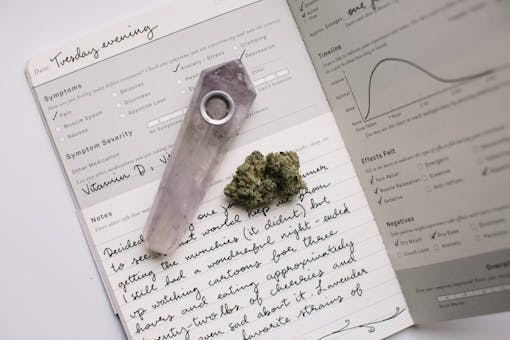Keeping a cannabis journal is a great way to help you maximize the power of cannabis consumption, particularly if you’re utilizing cannabis as part of your wellness or medical regimen. Individual strains impact everyone differently, and remembering whether it was Blue Dream, Blue Cheese, or Blueberry that you liked so well on your last trip to the dispensary can get a little hazy—particularly when different growers’ strains will have different characteristics, too.
Not sure where to start? Check out the following insight, tips, and tricks to make keeping a cannabis journal as easy as updating your status.
Step 1: Get Behind the Concept

(Julia Sumpter for Leafly)
Why is keeping a cannabis wellness journal so important? First, it makes it easier to keep track of things that don’t agree with you. Have you ever vaped something that made you feel totally lethargic and found yourself wondering whether you should have known to avoid this strain? With a cannabis journal, you can simply flip back and reference whether you’ve tried a certain strain before and how you felt about it.
It also makes it easier to see patterns. Perhaps you’re experiencing cannabis-induced paranoia only on the days that you also consume coffee, but unless you write those things down over the course of several days or weeks, it can be hard to decipher those connections.
Furthermore, you’ll have a record that you can go over with your budtender or even your doctor if need be. They might, with objective eyes, see things that you miss, which can help them modify their recommendations to better suit your personal experiences.
Finally, journaling is good for your overall health. Studies have found that journaling helps to improve self-confidence, hone communication skills, and even increase your IQ!
Step 2: Figure Out Your Medium
Are you the kind of person who prefers to write things longhand or utilize a memo app on your phone? Perhaps the more important question is: What type of journal will you keep up with every single day? The biggest and perhaps most difficult part of keeping any sort of journal is keeping up with it daily.
Shop highly rated dispensaries near you
Showing you dispensaries nearIf you prefer digital journaling, find an app that will remind you during the day to keep up with your notes. If you prefer an old-school approach, consider investing in a nice physical strain journal such as Goldleaf’s Patient Journal or The Chronnoisseur’s Complete Tasting Journal. Keep it by your bed or somewhere that you won’t be tempted to ignore it. Writing longhand can be beneficial—studies have shown that it keeps your mind sharp and helps you learning—but it’s not convenient for everyone, so choose the medium that works best for you.
Step 3: Decide What to Write

(Julia Sumpter for Leafly)
Cannabis journals can be a great way to help you make sense of your favorite strains and how they can complement your lifestyle, but what sort of things should you be writing about?
- Starting state of mind. How were you feeling before you smoked, vaped, or had an edible? Were you stressed about work? Tired from a long day? If you were experiencing anxiety, was it unusually pronounced? Be sure to note anything out of the ordinary.
- Cannabis intake. Keep track of the strain and brand, the consumption method you used (be specific—“One half-gram pre-roll” is better than “Smoking”), when you consumed (time of day as well as things like whether it was before or after a meal), how quickly you started to feel effects (particularly with edibles), and so on. Be sure to note the dispensary you picked the product up from so you can track it down again if you loved it.
- Cannabis effects. How intense were the effects? When did they start to taper off? What did you like or dislike about your experience? Maybe you found a strain that you loved for the most part, but that gave you dry mouth—if so, you can ask your budtender for something similar with less likelihood of causing dry mouth next time.
- Food and water intake. Did you have a huge brunch? It might have been the eggs benedict making you sleepy all afternoon, not the Golden Goat. Keep track of whether you ate less or more than average, whether you ate anything unusual, whether you drank coffee, tea, or alcohol, whether you felt dehydrated, and so on.
- Pain, illness, or allergies. This could include allergies to food, environmental allergies (pollen, dust, pets), sharp or dull pain, or symptoms of any illness that you experience. If you’re taking medications or supplements besides cannabis, list those as well.
- Sleep. How many hours of sleep are you getting? Are you sleeping straight through or waking frequently? You can use an app such as Sleep Cycle to help you keep track of how well you’re sleeping.
- Exercise. Record your physical activity, whether that means workouts or just the step counts on your fitness tracker.
- Hormone changes. For women, this should include menstrual cycles.
Try to record all the same items every single day, even if you don’t consume any cannabis. You might not need to record everything that we’ve listed here—these are just suggestions. A cannabis wellness journal is something that’s exclusively yours, so feel free to modify it as you go.
Step 4: Schedule Your Journaling Time
Schedule your journaling time each day, whether you choose to spend just a few minutes or a half-hour at a time. Writing in your journal first thing in the morning is a great way to analyze your sleep and to see how you’re feeling before you’ve consumed any cannabis. Meanwhile, journaling in the evening allows you to look over the day, analyze any mood shifts, and see how your intake of cannabis, caffeine, food, water, and other medications affected you throughout the day. If you like, you can even do both. If you forget to journal for a few days, don’t give up—start back in and keep trying until you solidify the habit.
Wellness journals are invaluable tools in making sense of this crazy thing we call life, particularly when we have such a wide world of cannabis strains and products at our disposal. Try writing in a cannabis wellness journal for a few weeks to see the kind of difference that it can make in your life.
Keeping a cannabis journal already? Share your experiences and advice in the comments!






